20 ChatGPT Statistics & Facts in 2026: OpenAI Chatbot Explanation, Stats & Trends
Since it burst onto the scene in 2022, ChatGPT has become one of the hottest topics in the tech world, and the world at large. If you’re wondering what all the fuss is about, read on for the 20 most interesting ChatGPT statistics and facts.
Late 2022 saw an explosion of public interest in artificial intelligence (AI), from image generation models like DALL·E 2 and Midjourney, to the language-based ChatGPT. Although the former caused controversy within the art scene, ChatGPT might be poised to create a paradigm shift in our everyday lives. Here are some ChatGPT statistics and facts to help prepare you for the AI-powered future.
Key Takeaways: ChatGPT Statistics 2026
- ChatGPT is an artificial intelligence model created by OpenAI that takes the form of a chatbot that can answer user queries and provide human-like conversations.
- OpenAI launched ChatGPT in November 2022 using GPT-3, one of the most advanced large language models, trained on over 45 million texts, using 175 billion parameters to analyze their contents.
- Although OpenAI launched the more advanced GPT-4 model, it’s available to only ChatGPT Plus users in a limited capacity at this time.
- More than 100 million individuals have used ChatGPT as of February 2023, becoming the online service with the most rapid rate of growth ever recorded.
Launched in November of 2022, ChatGPT is an AI that uses a language model created by OpenAI. ChatGPT takes the form of a chatbot that allows ChatGPT users to have a conversation with the AI as if it were a person.
However, it can do much more than small talk, though. It’s knowledgeable about almost any topic you could think of, and its uses can vary from generating recipes, to helping kids with their homework, to writing code in several programming languages. Read on to learn more about ChatGPT and how it might change the world we live in.
Note: Updates to ChatGPT are happening rapidly; we will do our best to keep this statistics article updated as new releases of GPT technology is released.
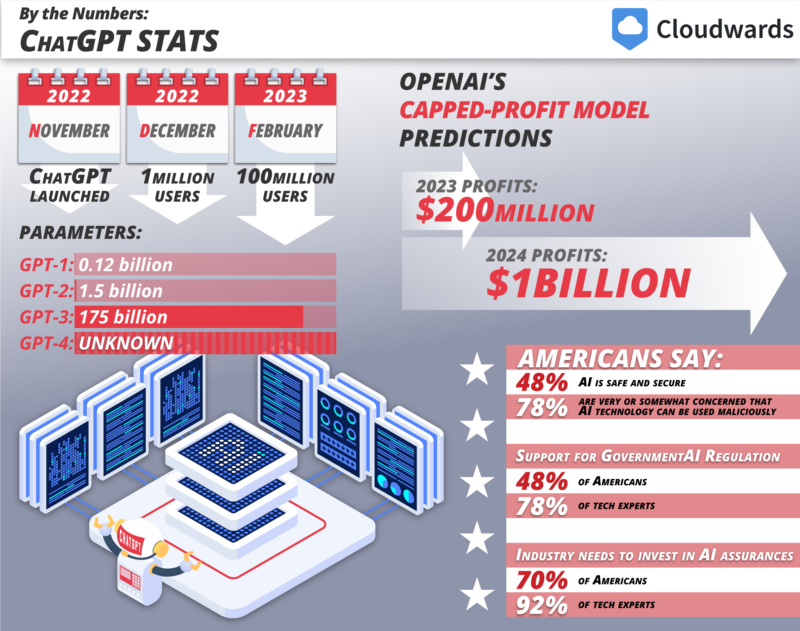
-
04/20/2023
Italy became the first country to ban ChatGPT over privacy concerns, and VPN usage skyrocketed 400% in the country, according to AtlasVPN.
20 ChatGPT Statistics & Facts
We’ve gathered all the most important statistics and facts about ChatGPT, covering its language model, costs, availability and much more. Let’s start things off with the basics.
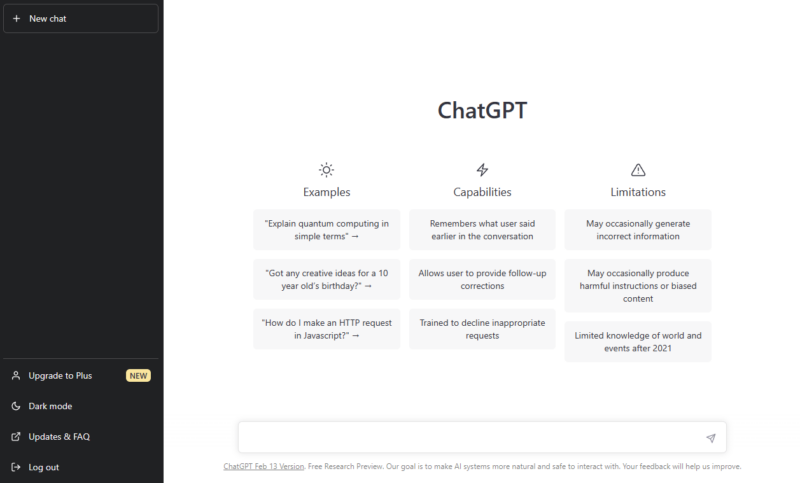
ChatGPT General Information
Here are the most interesting ChatGPT statistics and facts about how it functions and what its limits are.
1. What Is ChatGPT?
OpenAI’s ChatGPT is an AI chatbot that responds to user queries with human-like text. It uses natural language processing (NLP) to learn from a massive set of data that is freely available on the internet. The answers it gives are far more detailed and natural-sounding than any of its predecessors, though users should take caution with the answers, as it isn’t always correct, especially on the GPT-3 model.
ChatGPT has a paid version called ChatGPT Plus, which can use the latest version of the technology called GPT-4. This version can yield more accurate results and more natural and concise answers.
2. What Is OpenAI?
As you may have assumed from its name, OpenAI is an AI-focused company that created and owns ChatGPT, as well as the popular AI image generator DALL·E 2.
Originally co-founded by Elon Musk in 2015 as a nonprofit (though he left the company in 2018), the San Francisco–based company has become a leader in AI technology. It has attracted major investments, most notably from Microsoft, which has integrated ChatGPT into its Bing search engine.4
3. How Does ChatGPT Work?
ChatGPT lets users ask complex questions and generates answers for them. Because it’s structured as a dialogue, users can iterate on ChatGPT’s answers by asking follow-up questions.
OpenAI has ChatGPT trained on “Reinforcement Learning from Human Feedback” (RLHF), which means ChatGPT can use the human feedback in the training loop to challenge incorrect premises. For example, if a user notices ChatGPT made a mistake, they can tell it the correct information, and ChatGPT will output a corrected answer.
Another way to iterate on an answer is by telling ChatGPT to change the tone of a message. For example, if you’ve told it to generate a cover letter for a job application, it can rephrase it to sound more professional. There are tons of other uses, like generating code, or writing emails and essays, and even product reviews.
4. Limitations of ChatGPT
That said, there are things that ChatGPT can’t do. ChatGPT was originally created with the intention to analyze, summarize and translate texts. However, with the second generation of the GPT model, OpenAI realized that it could be used to pump out massive amounts of fake news.
This is why ChatGPT will refuse to generate text that references what it believes is false information. In such cases, it will let you know that the premise of your question isn’t factual, and will further explain the factually correct answer.

There are other limits to ChatGPT, though. It will reject inappropriate requests and won’t output answers that:10
- Promote or assist illegal activity, including generating malware code
- Are inappropriate, sexually explicit, discriminatory or otherwise offensive
- Might be used in political campaigning or lobbying, beyond providing information
- Violate the privacy or security of an individual
- Require human judgment or decision-making, including medical diagnoses
- Might lead to the user’s physical or economical harm, including financial advice
- Are of a personal nature to the asker
Furthermore, it can’t answer questions that it has no information about, and it might refuse to answer an ambiguous question, asking for further clarification. Additionally, its data set is limited to events before 2021. This means that ChatGPT can’t give you answers about current events, or anything that’s happened after 2021.
5. Can ChatGPT Make Mistakes?
Of course, sometimes ChatGPT can be just plain wrong. As with all AI language models, ChatGPT suffers from AI hallucination.7 This is a condition where an AI will generate a convincing answer that might be supported by the data it was trained on, but has no basis in reality.
If you ask it for a source for the wrong information it gave, it might even generate a nonexistent link with a plausible-sounding URL.
The latest version of ChatGPT based on GPT-4 has a reduced occurrence of hallucination, though it’s not completely immune to it.
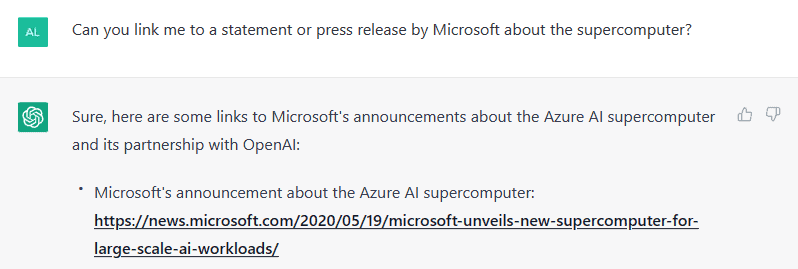
6. Is ChatGPT Biased?
ChatGPT displays leftist and especially environmentalist leanings, according to a joint study by staff from the Technical University of Munich and the University of Hamburg Business School.11 It was prompted using questions from the leading voting advice applications in Germany and the Netherlands, as well as the political compass test.
Going by the answers it gave, if ChatGPT were a person, it would most likely vote for the Greens (around 72% support), though it also favored the socialist Linke (around 67% support) and social democrat SDP (around 65% support) parties in Germany.
It most disagreed with the nationalist AFD party (around 38% support), though the liberal FDP and conservative CDU party got the same amount of support (around 55% support, each).
The popular political compass test placed ChatGPT as a center-left libertarian. The reasons for its political leanings could be from the web-scraped data used to train ChatGPT, from the human AI trainers, or from OpenAI’s content moderation filters.11
GPT-4 has been specifically trained to reduce biases as much as possible, so results using that version of ChatGPT might vary.
Technical ChatGPT Statistics
The following statistics talk about how ChatGPT works on a deeper level, how it was trained and the hardware it runs on.
7. Training the ChatGPT Language Model
The ChatGPT model is built on the third generation of OpenAI’s generative pretrained transformer (or GPT-3) language model family. The deep-learning model was trained on the WebText dataset, which uses the text from around 45 million links found on Reddit, excluding Wikipedia pages.1 GPT-3 is a pretrained model, and its dataset is limited to information from before its two-month training in 2021.
ChatGPT also relies on reinforced learning from human feedback (RLHF) to improve its functionality. Users can like or dislike an answer, as well as give written feedback for specific answers.
The Plus version of ChatGPT uses the latest iteration of the GPT model, called GPT-4. This iteration uses the same dataset, but with further training and fine-tuning implemented to reduce biases and make ChatGPT more human-like. GPT-4 can answer more nuanced queries and give more creative answers to abstract questions, and it can handle more complex tasks than its predecessor.13
In the future, GPT-4 might become the standard for ChatGPT as the platform evolves and matures, though it seems that the current plan is to keep the feature limited to paying users.
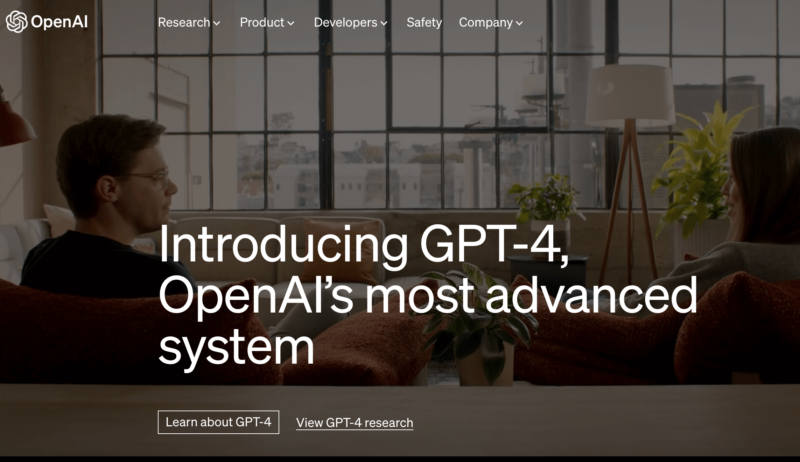
8. How Advanced Is ChatGPT’s Natural Language Processing?
ChatGPT’s natural language processing uses parameters, with GPT-3 using 175 billion — compared to 1.5 billion for GPT-2 and just 0.12 billion for GPT-1.2 This is extremely complex for a publicly available AI and these parameters let ChatGPT gauge the relationships between words, phrases and sentences in the dataset it was trained on.
The number of parameters for GPT-4 is currently unknown, but it is capable of more complex problem-solving, analyzing visual images — and even passing a simulated bar exam in the top 10%.13
For instance, consider a scenario where you want to blur the background of an image. The advanced GPT-4 could potentially assess the image, understand the need to highlight a specific object and suggest suitable actions like background blur. This exemplifies its enhanced versatility and improvements in AI capabilities.
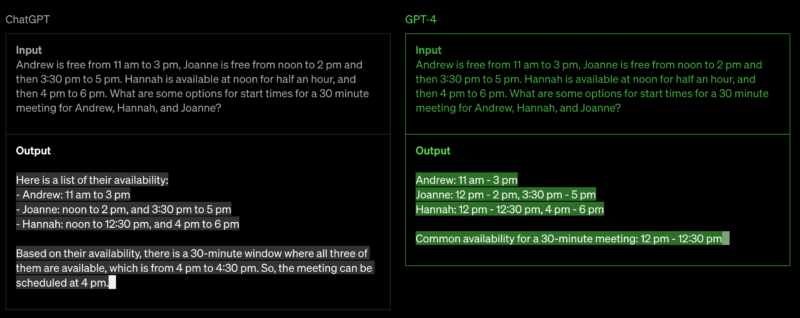
9. What Is the Hardware Behind ChatGPT?
All of this requires a lot of computational power, which is why GPT-3 (and by extension ChatGPT) uses one of the largest supercomputers in the world, namely Microsoft’s Azure AI supercomputer.
Built using Microsoft’s Azure cloud infrastructure in partnership with OpenAI, the supercomputer runs on 285,000 CPU cores and 10,000 GPUs, with 400 Gbps of network connectivity.3
ChatGPT User Statistics
These additional ChatGPT statistics relate to its users, how much they can expect to spend on it and how much OpenAI might earn from its monetization.
10. The Number of ChatGPT Users
Within just a few days of its Nov. 30, 2022 launch, ChatGPT crossed the million-user threshold on Dec. 5, 2022.8 By the start of February 2023, it reached 100 million unique visitors, with over 25 million daily visits.9 This makes it the fastest growing consumer service in history.
11. ChatGPT Costs
The consumer version of ChatGPT is currently free to use, though users can pay a fee of $20 per month for ChatGPT Plus. The premium subscription adds three benefits:
- Access to ChatGPT even in high-load situations (ChatGPT is often at capacity, making it impossible to use)
- Faster responses
- Access to any new features, including GPT-4
GPT-4 queries are limited depending on server load, so you might only get to ask the advanced model a few questions before you’re forced to wait for your quota to refresh.
Developers can integrate ChatGPT into their products and websites at a cost of $0.002 per 1,000 tokens (where 1,000 tokens roughly equals 750 words). GPT-4 integration is a little pricier, at $0.03 for 1,000 prompt tokens and $0.06 for 1,000 completion tokens.
12. ChatGPT Revenue
Although OpenAI was formed as a nonprofit, it has since transitioned into a capped-profit model. ChatGPT has been a major source of revenue for OpenAI, which predicts that it will earn around $200 million in 2023, and $1 billion in 2024.5 In March 2023, the company was valued at around $29 billion dollars — a 100% jump from its 2021 valuation.6
The Future of ChatGPT
Even though we’re still testing the limits of what AI can do, we can speculate on what its future might be like. Here are a few ways we believe ChatGPT might evolve in the future.
13. AI Search Engines
We’ve already seen steps toward AI chatbots in the form of Siri and Google Assistant, and ChatGPT or ChatGPT alternatives are the next natural step. Using natural language processing might help users search for information more organically and receive search results that are more relevant to their queries.
ChatGPT’s integration into Bing might even help break Google’s hegemony over the world of internet searches — though we’re not holding our breath, especially with it developing its own AI chatbot, Bard.
14. ChatGPT Concerns
It’s natural to fear a new technology that’s difficult to understand, and so far Americans have a long way to go with AI. Only 48% think AI is safe and secure, and 78% are very or somewhat concerned that AI technology can be used maliciously, according to a MITRE-Harris Poll survey.14
It’s not surprising, then, that 82% of Americans and 91% of tech experts support government regulation, plus 70% of Americans and 92% of tech experts say the industry needs to invest in AI assurance measures for the public.14
Using ChatGPT As a Tool
Millions of people are already using ChatGPT everyday. Here are some top uses for how the AI chatbot could be used.
15. Using ChatGPT for Homework
Students of all ages quickly learned that they can use ChatGPT to do their high school homework, and even generate college-level essays. One study found that 89% of students used ChatGPT to help with homework assignments.12 Educators are still grappling with how to handle the use of ChatGPT, with some of them claiming it will lead to complacency in students.
Of course, we do not condone the use of AI tools to do your work for you, but ChatGPT will likely be a powerful tool for research, and it may even help teachers more than it does students.
16. Personalized Education
A powerful language model like ChatGPT can be used to analyze a student’s way of learning, allowing teachers to tailor the way they teach to each individual student’s needs. This can optimize the way we learn, and it could especially help underachievers and children with learning disabilities.
A large language model can also help teachers streamline their lesson plans by analyzing the material and deciding the most logical order for the lessons. Some teachers are already using it to generate writing prompts or as a general teaching aide.12
17. Medical Diagnoses
Although ChatGPT can’t answer queries about medical diagnoses, a modified version designed to assist a real medical professional might help them realize a potential diagnosis or treatment they might otherwise miss.
18. Customer Support
As an intelligent chatbot, it’s easy to imagine how integrating ChatGPT into customer support chats might help improve the customer support experience, especially for services and websites that can’t afford live agents. Beyond searching for information, ChatGPT might be able to provide advice specific to the customer’s problem.
19. Business
Besides the obvious application of being a personal assistant, ChatGPT might be able to assist in sales and marketing by analyzing customer data, and creating new business and marketing strategies or identifying new opportunities.
20. Writing With ChatGPT
Publications are already using AI tools — ChatGPT included — to write articles. One notorious example is CNET, which has been using AI to write articles, with varying success. A journalist at Buzzfeed News ran their own test of ChatGPT’s writing chops, getting it to write an article about the failings of CNET’s AI articles.
Needless to say, an article written solely by an AI that is known to include factual inaccuracies is a bad idea, though there is some merit to using it for writing. It can help a writer search for information that they can check against another source, and ChatGPT might even be able to link you to additional sources.
Although using AI-generated content and passing it off as your own is frowned upon, there is still merit to using ChatGPT as a tool to assist your writing. After all, writers have always made use of dictionaries, thesauruses and rhyming dictionaries. ChatGPT might present an easier way to look for synonyms and rhymes or rephrase clumsy sentences.
Other AI Chat Tools
ChatGPT isn’t the only large language model out there. Google released its own AI chatbot, called Bard. Unfortunately, Bard made a factual error during its unveiling, resulting in a $100 million drop in stock for Alphabet — Google’s parent company.
Ernie Bot, which is in development by Chinese tech giant Baidu, is expected to join the fray in 2023. It will be based on the ERNIE large language model introduced in 2019 and iterated in 2021 as ERNIE 3.0 Titan.
If the information from Baidu is true, the language model uses 260 billion parameters and an extremely large database, which would make it technically more advanced than GPT-4. It will likely be years before people can say which is the best AI chatbot tool.
Read our AI writing statistics article for an insight into the different industries the technology is used in.
Final Thoughts: ChatGPT
Just a few years ago, an intelligent AI seemed like science fiction, yet ChatGPT has managed to draw the attention of the entire world with its conversational capabilities and wealth of information. Although we still have our reservations about running ChatGPT for certain uses, we can’t help but wonder what the future might hold if we embrace AI technology. ChatGPT is punching us head-first into that future.
If the new AI chatbot is not running for some reason, you can check out our ChatGPT troubleshooting guide. If it is banned in your country or workplace, making it impossible to try, fret not. We have a comprehensive guide on how to unblock ChatGPT using a VPN.
What are your thoughts on ChatGPT? Are you excited for the new horizons it might open, or are you wary of anything AI? Leave your thoughts in the comments below, and as always, thank you for reading.
Sources:
- OpenAI — Language Models are Unsupervised Multitask Learners
- OpenAI — Language Models Are Few-Shot Learners
- Microsoft
- Bloomberg
- Reuters
- Wall Street Journal
- Association for Computing Machinery
- Sam Altman (cofounder of OpenAI) on Twitter
- Similarweb
- OpenAI — Usage Policy
- Technical University of Munich & University of Hamburg
- Study.com
- OpenAI — GPT-4
- MITRE-Harris Poll
FAQ
ChatGPT is the fastest growing service in the history of the internet. In February 2023, it reached the 100 million user mark.
GPT-3 is trained on around 45 million texts from all over the internet, compiled into the WebText dataset.
Although Elon Musk is one of the co-founders of OpenAI, he left the company’s board in 2018, when it decided to move to a capped-profit model.
ChatGPT is free to use, though you might run into congestion issues if there is too high a server load. ChatGPT Plus is a $20 monthly subscription that gets you priority access, even if the servers are at full capacity.
The number of users is growing steadily; it’s estimated that there are over 100 million users on ChatGPT.


